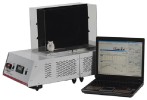Authors
B. Petita, F. Giraudetb, C. Béchona, L. Bardinf, P. Avan et al.
Lab
Université d'Auvergne, Clermont-Ferrand, France
Journal
Neurobiology of Disease
Abstract
mutations in the gene encoding the major myelin protein of the central nervous system, proteolipid protein 1 (PLP1), cause an X-linked form of spastic paraplegia (SPG2) associated with axonal degeneration. While motor symptoms are the best known manifestations of this condition, its somatosensory disturbances have been described but poorly characterized. We carried out a longitudinal study in an animal model of SPG2 — mice carrying a deletion of the Plp1 gene (Plp- mice). Plp- mice exhibited severe early-onset thermal hyperalgesia, in the absence of thermal allodynia. We first performed an electrophysiological testing which showed an early decrease in peripheral and spinal conduction velocities in Plp mice. Such as the abnormal sensitive behaviors, this slowing of nerve conduction was observed before the development of myelin abnormalities at the spinal level, from 3 months of age, and without major morphological defects in the sciatic nerve. To understand the link between a decrease in nerve velocity and an increased response to thermal stimuli before the appearance of myelin abnormalities, we focused our attention on the dorsal horn of the spinal cord, the site of integration of somatosensory information. Immunohistochemical studies revealed an early-onset activation of astrocytes and microglia that worsened with age, associated later in age with perturbation of the expression of the sensory neuropeptides calcitonin-gene-related peptide and galanin. Taken together, these results represent complementary data supporting the hypothesis that Plp- mice suffer from ganglionopathy associated with late onset central demyelination but with few peripheral nerve alterations, induced by the glial-cell-mediated sensitization of the spinal cord. The mechanism suggested here could underlie pain experiments in other leukodystrophies as well as in other non-genetic demyelinating diseases such as multiple sclerosis.
BIOSEB Instruments Used:
Cold Hot Plate Test (BIO-CHP),Thermal Place Preference, 2 Temperatures Choice Nociception Test (BIO-T2CT)

 Douleur - Allodynie/Hyperalgésie Thermique
Douleur - Allodynie/Hyperalgésie Thermique Douleur - Spontanée - Déficit de Posture
Douleur - Spontanée - Déficit de Posture Douleur - Allodynie/Hyperalgésie Mécanique
Douleur - Allodynie/Hyperalgésie Mécanique Apprentissage/Mémoire - Attention - Addiction
Apprentissage/Mémoire - Attention - Addiction Physiologie & Recherche Respiratoire
Physiologie & Recherche Respiratoire
 Douleur
Douleur Métabolisme
Métabolisme Système moteur
Système moteur Neurodégénérescence
Neurodégénérescence Thématiques transversales
Thématiques transversales Système musculaire
Système musculaire Functions de motricité générale
Functions de motricité générale Troubles de l'humeur
Troubles de l'humeur Other disorders
Other disorders Joints
Joints Système Nerveux Central (SNC)
Système Nerveux Central (SNC)  Système sensoriel
Système sensoriel

